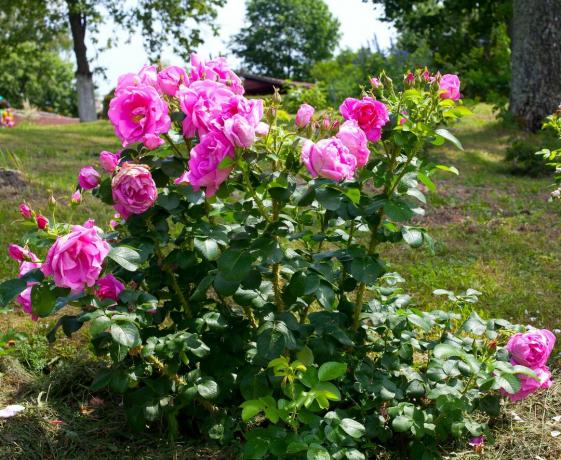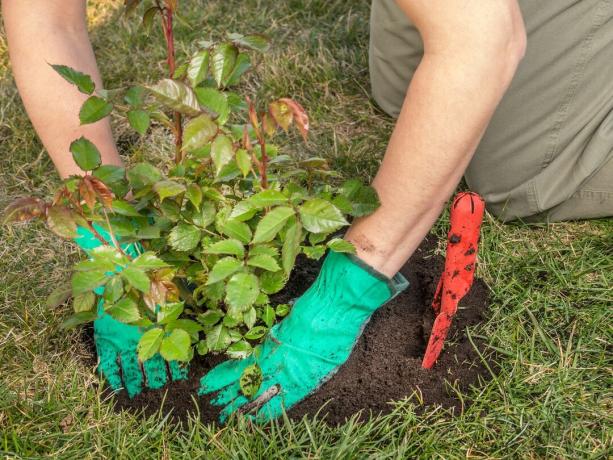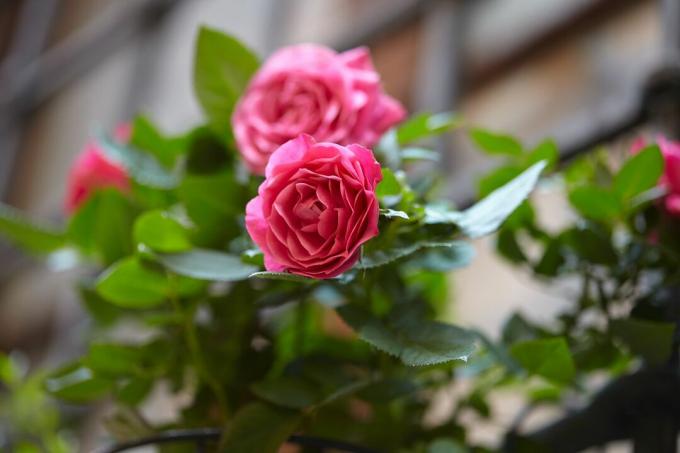There are a few things to consider when planting roses. Here you can find out everything from the right location to the right time to plant roses in the garden.

the rose (pink) is not called the "Queen of Flowers" for nothing. It is one of the most beautiful flowering shrubs, especially since it is usually particularly emphasized when planted in the garden. There is a large selection of different types of roses: whether red or white, Climbing or Floribunda rose - You will always find what you are looking for in larger nurseries or tree nurseries. So that the selected rose will thrive in your garden, we will explain in more detail in this article which aspects you should definitely pay attention to when planting.
Together with other genres - such as the blackberry (Rubus) or the Apple (Malus) - the rose forms the large rose family (Rosaceae). And from this affiliation there are special requirements for the optimal location. Below we will go into more detail about the correct planting.
contents
- The perfect location for roses
- When to plant roses
- Plant roses in the bed
- Plant roses in a pot
- Caring for roses after planting
The perfect location for roses
Roses prefer open, airy areas with lots of sun and warmth. Strong temperature fluctuations between day and night can be a danger, especially in early spring. It is therefore best to choose a sheltered place for your darling. The plant should not be placed too close to a house wall, because the rose does not tolerate heat build-up either. It should also keep a sufficient distance from other plants.
In addition to the right location, the best garden soil for roses is just good enough. This should be deep, loose and nutritious, the pH value between 6.5 and 7.0 in the neutral to slightly acidic range. After a few years, however, the soil can become “rose-tired” - before a new rose cultivation should take place You should therefore use other ornamental plants that do not belong to the rose family, plant.

Tip from the professional: Some rose connoisseurs recommend the intermediate culture of Marigolds (Tagetes patula) to avoid harmful nematode species in the soil, as these are made jointly responsible for the occurrence of soil fatigue. However, the cause of this phenomenon has not yet been fully clarified.
When to plant roses
You can basically buy container plants all year round, even in summer. It is best to plant roses in autumn (October / November), because then they have enough time to take root over the winter. In rougher locations, roses can still be planted in spring, but they must be watered particularly well when the budding begins.
Plant roses in the bed
Before planting, you should loosen the soil and, if necessary, improve it with a bucket of ripe compost. Roses without balls should be watered for a few hours before planting (up to 24 hours for spring planting). Container roses also grow better if the pot ball is immersed in water before planting until it sinks and no more air bubbles rise. After watering, you should cut off damaged roots smoothly and shorten all others to about 30 cm.
Dig out the planting hole about twice as large as the roots. Then insert the rose so that the grafting point is about three fingers' widths below the surface after it has been inserted. Then fill the planting pit with a mixture of garden soil and compost. If necessary, you can also incorporate some organic long-term fertilizer. Then step on the earth lightly. Finally, water the newly planted plant well, because it is only when it is sludged that the earth settles and surrounds the roots. Finally, pile up the plant about 20 cm high so that it is protected from drying out by wind and sun.

Summary of planting roses:
- Loosen the soil
- Immerse the roots of the pot in water
- Shorten the roots
- Dig the planting hole twice as large as the roots of the plant
- Do not insert the rose too deeply
- Top up with soil and compost
- Tread the soil lightly and water it well
- Pile about 20 cm high
Plant roses in a pot
If you don't have your own garden, you can also plant roses in a pot or container. Since roses have very deep roots, you should choose a planter of sufficient size. Every few years the soil has to be replaced with fresh substrate so that the plant has enough nutrients available again. Special soil for roses is available in stores, but you can also easily mix equal parts garden, compost and potting soil. A sunny, airy spot on the balcony or terrace is ideal as a location.
Different sorts of dwarf roses, bed roses or hybrid tea roses with a compact growth are suitable for potting. When buying, however, make sure that the planting material is healthy and free from pests. Pot roses are generally more susceptible to disease and also need to be watered more regularly than plants in the open. More information about Roses in the pot can also be found here in our special article.
Tip from the professional: Pot roses do not tolerate waterlogging well. It is therefore best to put in a drainage layer made of gravel or expanded clay so that excess irrigation water can drain off.

Caring for roses after planting
If you have already ensured good starting conditions for planting, the maintenance effort for roses is limited. In spring (March / April) you should make a maintenance cut and basic fertilization. Our Plantura organic rose fertilizer with long-term effect your roses with all the important nutrients. You should also ensure adequate watering during long dry periods. In areas with a harsher climate, it must also be borne in mind that some types of roses are only partially hardy. Therefore, special winter protection measures may be necessary so that your rose can get through the cold months.
In this special article you will find detailed information about the Rose care. More details on the to water, Cut and Fertilizing your roses you can also read in the corresponding articles on the respective topic.



